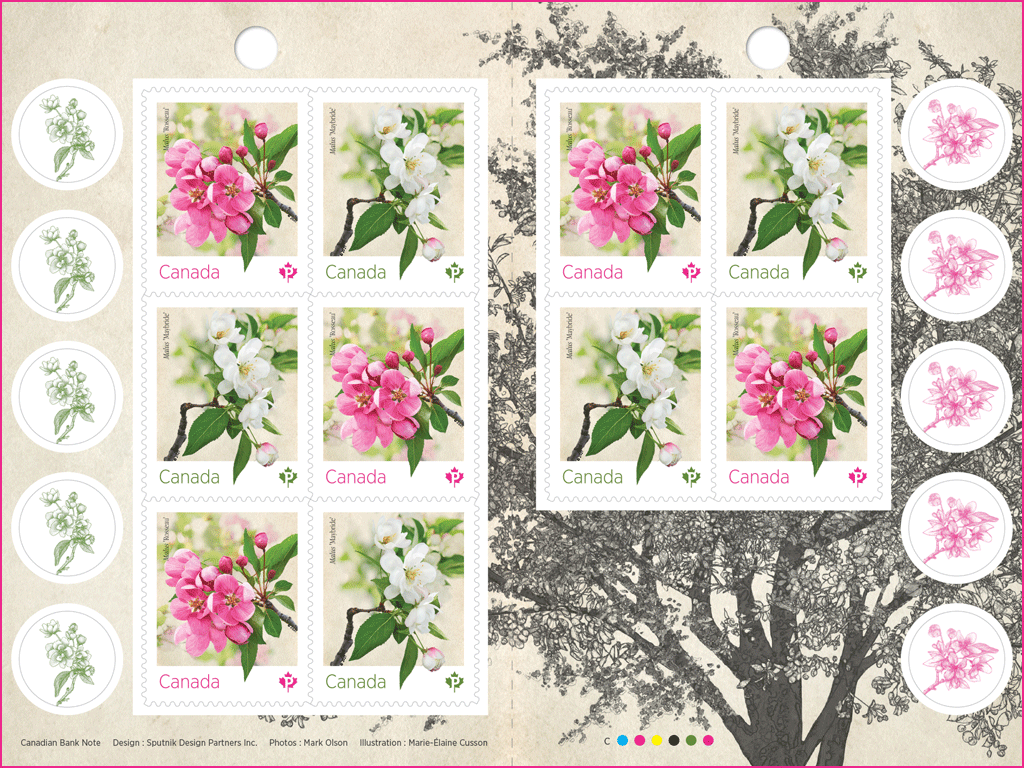Issue date: March 1, 2021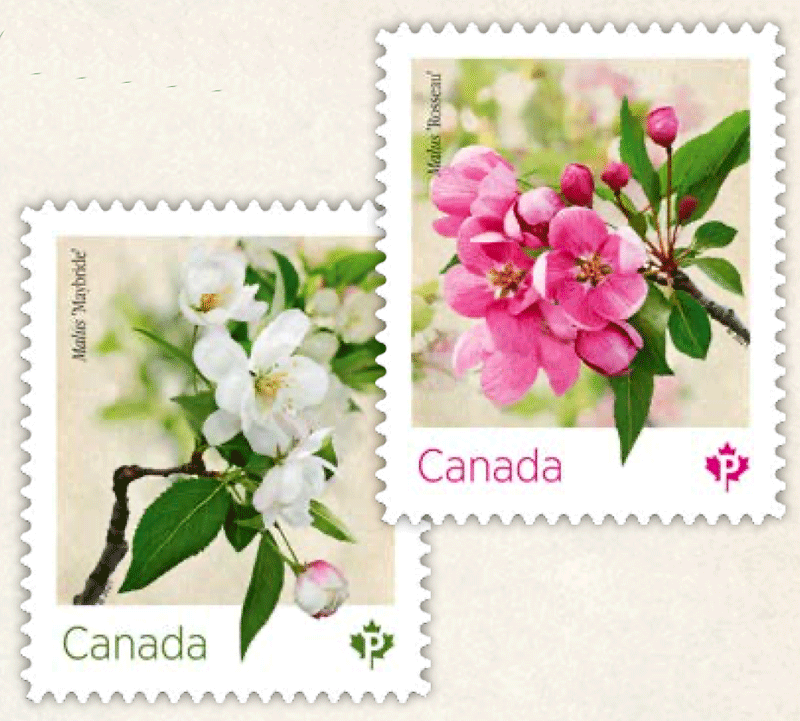
From Details magazine:
The sweet fragrance of a crabapple tree in bloom is one of the most pleasant reminders that spring is, quite literally, in the air. The blossoms depicted on this year’s flower stamp issue pay tribute to two Canadian-bred varieties.
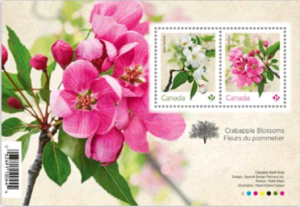 The pretty bright-pink flower of Malus ‘Rosseau’ was introduced in 1928 by the Central Experimental Farm’s pioneering ornamental plant breeder, Isabella Preston. The delicate white bloom of Malus ‘Maybride’ is a dwarf cultivar bred by Preston’s successors, Daniel Foster Cameron and Dexter Reid Sampson.
The pretty bright-pink flower of Malus ‘Rosseau’ was introduced in 1928 by the Central Experimental Farm’s pioneering ornamental plant breeder, Isabella Preston. The delicate white bloom of Malus ‘Maybride’ is a dwarf cultivar bred by Preston’s successors, Daniel Foster Cameron and Dexter Reid Sampson.
While the scented blossoms are much welcomed in the spring, the trees, common to many Canadian yards and gardens, are often grown for the jams and jellies that can be made from the small, somewhat sour 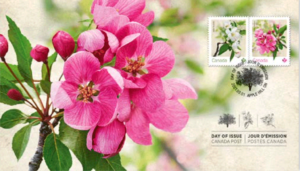 fruit. Serious foodies also note that crabapple wood is excellent for smoking meats and cheeses.
fruit. Serious foodies also note that crabapple wood is excellent for smoking meats and cheeses.
Designed by Sputnik Design Partners Inc., with illustration by Marie-Élaine Cusson and photography by Mark Olson, the booklet, souvenir sheet and Official First Day Cover were printed by Canadian Bank Note and the coils by the Lowe-Martin Group. 
Updated March 1st: Day of Issue press release
[press release]
Stamps showcase crabapple blossoms with Canadian origins
Renowned Canadian plant breeder and her successors behind these two cultivars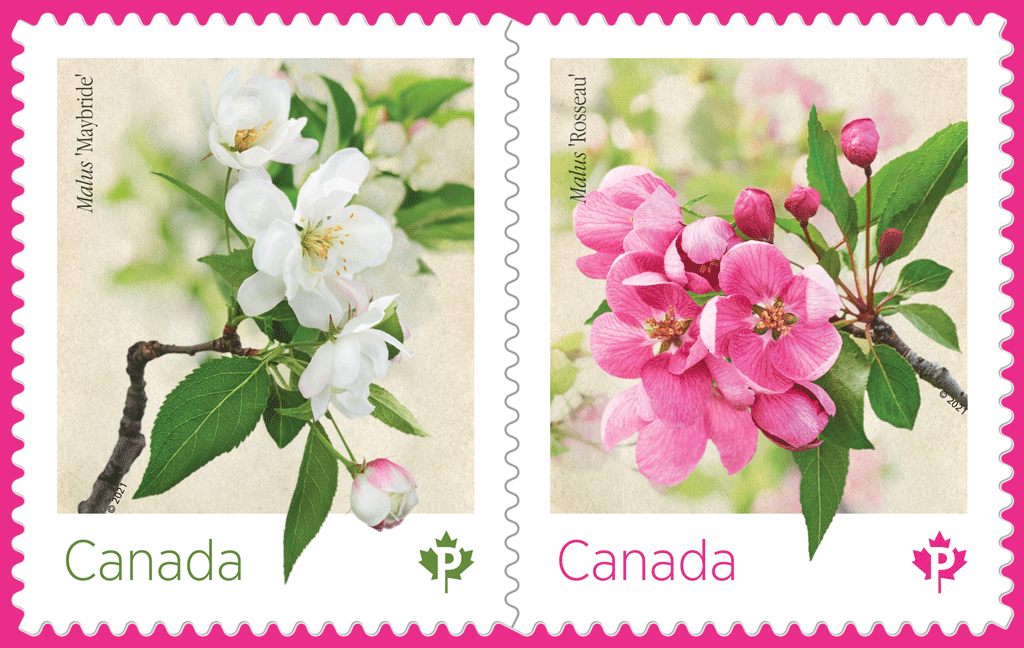 Click on picture above for a larger version
Click on picture above for a larger version
OTTAWA – Today, Canada Post released the latest in its popular flower series, a two-stamp issue showcasing the blossoms of crabapple tree cultivars with a Canadian distinction, the Malus ‘Rosseau’ and Malus ‘Maybride’.
The pretty pink flower of the Malus ‘Rosseau’, bred by renowned ornamental plant breeder 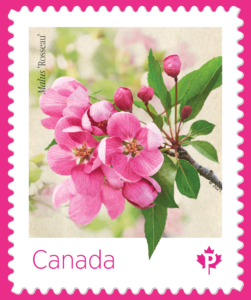 Isabella Preston, was first introduced at the Central Experimental Farm in Ottawa in 1928. The delicate white bloom of Malus ‘Maybride’, a dwarf cultivar bred by Preston’s successors Daniel Foster Cameron and Dexter Reid Sampson, was first made available to the public in 1973.
Isabella Preston, was first introduced at the Central Experimental Farm in Ottawa in 1928. The delicate white bloom of Malus ‘Maybride’, a dwarf cultivar bred by Preston’s successors Daniel Foster Cameron and Dexter Reid Sampson, was first made available to the public in 1973.
Canada is home to several wild species and hundreds of cultivars of crabapple trees, which like apple trees belong to the rose family. Gardeners plant crabapple trees for their fruit, their hardiness and their spectacular, fragrant blossoms. While sour to the taste, the tree’s fruit makes excellent jams and its wood is often used for smoking meat and cheese. Crabapples are also an important food source for mammals, birds and insects.
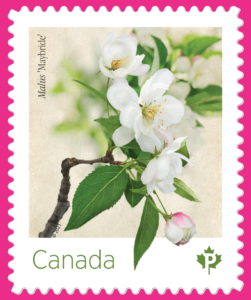 Introduced in 2005, the annual flower stamp issue has long been a bestseller and is often used on wedding stationery, including invitations. This year’s stamps were designed by Sputnik Design Partners Inc. of Toronto and feature photographs by Mark Olson, with background line illustrations by Marie-Élaine Cusson.
Introduced in 2005, the annual flower stamp issue has long been a bestseller and is often used on wedding stationery, including invitations. This year’s stamps were designed by Sputnik Design Partners Inc. of Toronto and feature photographs by Mark Olson, with background line illustrations by Marie-Élaine Cusson.
The stamps are sold in a booklet of 10 – five each of the two designs – and in a convenient coil of 50, offering 25 of each design. A two-stamp souvenir sheet is available for collectors, along with strips of four and 10 stamps from the coil. The Official First Day Cover of the combo is cancelled in Apple Hill, Ontario. The booklet, souvenir sheet and Official First Day Cover were printed by Canadian Bank Note and the coil by Lowe-Martin.
Stamps and collectibles are available at canadapost.ca [direct link] and postal outlets across Canada.
Canada Post has produced a 15-second video for this issue:
Deux timbres illustrent des fleurs de pommetier du Canada
Une pionnière en hybridation des plantes et ses successeurs sont à l’origine des deux cultivars illustrés

OTTAWA – Aujourd’hui, Postes Canada a lancé sa plus récente émission de la série consacrée aux fleurs, un jeu de deux timbres illustrant des fleurs de cultivars de pommetiers propres au Canada, le Malus ‘Rosseau’ et le Malus ‘Maybride’.
 La jolie fleur rose du Malus ‘Rosseau’ a d’abord été introduite à la Ferme expérimentale centrale d’Ottawa en 1928 par Isabelle Preston, spécialiste de l’hybridation des plantes ornementales. La délicate fleur blanche du Malus ‘Maybride’, un cultivar nain produit par les successeurs d’Isabella Preston, Daniel Foster Cameron et Dexter Reid Sampson, a été offerte au public pour la première fois en 1973.
La jolie fleur rose du Malus ‘Rosseau’ a d’abord été introduite à la Ferme expérimentale centrale d’Ottawa en 1928 par Isabelle Preston, spécialiste de l’hybridation des plantes ornementales. La délicate fleur blanche du Malus ‘Maybride’, un cultivar nain produit par les successeurs d’Isabella Preston, Daniel Foster Cameron et Dexter Reid Sampson, a été offerte au public pour la première fois en 1973.
Au Canada, il existe plusieurs espèces sauvages et des centaines de cultivars de pommetiers qui, tout comme les pommiers, appartiennent à la famille des rosiers. Les jardiniers les plantent pour leurs fruits, leur rusticité et leurs superbes fleurs parfumées. Bien que suret au goût, le fruit du pommetier produit d’excellentes confitures et autres conserves. Le bois est souvent utilisé pour fumer la viande et les fromages. Le fruit du pommetier est aussi une source importante de nourriture pour plusieurs mammifères, oiseaux et insectes.
 Introduite en 2005, l’émission de timbres annuelle consacrée aux fleurs connaît toujours un grand succès et les vignettes sont souvent utilisées sur les faire-part, notamment pour les mariages. Les timbres de cette année ont été conçus par Sputnik Design Partners Inc. de Toronto avec les photographies de Mark Olson et les illustrations au trait en arrière-plan de Marie-Élaine Cusson.
Introduite en 2005, l’émission de timbres annuelle consacrée aux fleurs connaît toujours un grand succès et les vignettes sont souvent utilisées sur les faire-part, notamment pour les mariages. Les timbres de cette année ont été conçus par Sputnik Design Partners Inc. de Toronto avec les photographies de Mark Olson et les illustrations au trait en arrière-plan de Marie-Élaine Cusson.
Les timbres se vendent en carnet de dix, cinq de chacun des deux motifs, et en rouleau pratique de 50, soit 25 de chaque motif. Les collectionneurs peuvent se procurer un bloc-feuillet de deux timbres ainsi que des bandes de quatre et de dix timbres de rouleau. Le pli Premier Jour officiel combine les deux timbres et porte la mention « Apple Hill, Ontario ». Le carnet, le bloc-feuillet et le pli Premier Jour officiel ont été imprimés par Canadian Bank Note et les rouleaux par Lowe-Martin.
Les timbres et autres articles de collection sont en vente à postescanada.ca et dans les comptoirs postaux partout au pays. 